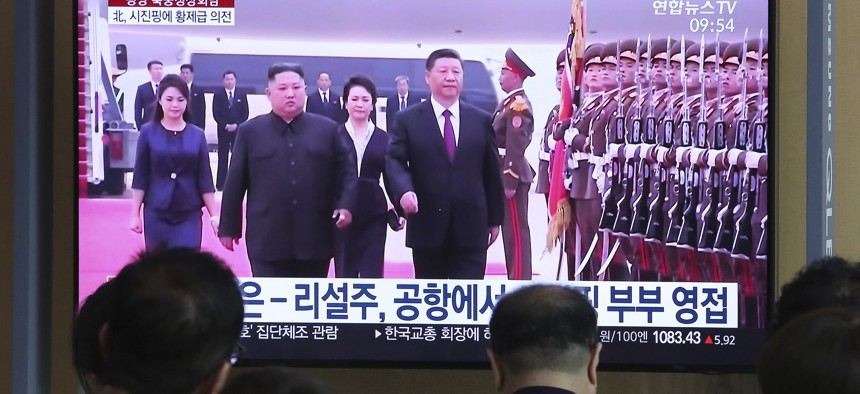
People watch a TV showing North Korean leader Kim Jong Un, second from left, welcoming Chinese President Xi Jinping at Pyongyang airport, at the Seoul Railway Station in Seoul, South Korea, Friday, June 21, 2019. AP Photo/Ahn Young-joon
China Should Consider Supporting a Korean Nuclear Deal
If Beijing hoped that a nuclear North Korea would decrease U.S. presence in the Pacific, that strategy has backfired.
The prospects for an arms control deal with North Korea remain unclear, although the Trump administration is determined to create a lasting security framework for Northeast Asia, including a nuclear-free Korean Peninsula. Despite establishment of communication between President Donald J. Trump and North Korea’s leader Kim Jong-un, progress including full denuclearization is unlikely without coming to terms with China’s history of nuclear proliferation to North Korea and its decision whether to continue to play a likely spoiler role in assuring such a framework.
The North Korean nuclear program started in 1965 with the Soviet construction of a 5-megawatt nuclear reactor. But it was Chinese and Pakistani assistance that enabled the North to begin construction on a 50-megawatt reactor at Yongbyon, and a secret reprocessing facility, in the mid-1980s. North Korean construction of a covert uranium enrichment facility around 2000 and North Korea’s first test explosion of a nuclear device in 2006 were likely enabled by assistance from the Pakistani A.Q. Khan, and based on uranium enrichment and nuclear design plans originally obtained from China.
China’s fingerprints on the origins and spread of nuclear weapons technology into North Korea suggest that the issue cannot be addressed without considering China’s strategic role and aims toward the peninsula and beyond.
What if the Chinese sought to aid the spread of nuclear weapons to North Korea in order to split U.S.-ROK relations? The calculation might be that such a development would heighten disagreement between the United States and South Korea and that the failure to secure an arms control deal “denuclearizing” the peninsula would eventually lead the United States to pull its military forces out of the Republic of Korea.
Related: Shanahan: ‘We’re Not Going To Ignore Chinese Behavior’
Related: Time to Abandon Denuclearization?
Related: Deter? Detente? NATO Has Lessons for the North Korean Conundrum
But the nuclearization of North Korea, regardless of North Korean or possibly Chinese motives, appears to have strengthened rather than weakened the U.S.-ROK alliance, contrary to Chinese expectations.
First, according to an ICAS-reported poll, nearly seventy percent of South Korean citizens want the United States to bring nuclear weapons back to the peninsula, or to develop their own nuclear weapons capability. This attitude is driven primarily by concern over the future reliability of the U.S. extended deterrent, as South Korea is faced with the growing threat of North Korean nuclear weapons.
Second, the United States has deployed missile defenses—the Terminal High Altitude Area Defense or THAAD—to the ROK that China vehemently opposed. Though the THAAD radar system can see North Korean missiles aimed at Seoul, it cannot see far enough into China to see Chinese missiles aimed at the ROK. Even so, China leveled serious economic sanctions and penalties on the Republic of Korea to try to reverse the decision. However, South Korea held solid.
Third, the ROK put together a new trade deal with the United States, further enhancing the alliance.
Fourth, the ROK increased its contribution to the support of American troops in South Korea to nearly $1 billion a year, a reciprocal and important step that symmetrically matched the U.S. increase in its own defense budget.
Fifth, the United States significantly increased its defense budget, adding $85 billion in each of the past two years, an increase of roughly 13%. A certain amount of this increase was for the defense of the ROK, Japan, and our Pacific allies.
Sixth, the United States expanded its planned missile defense systems defending the U.S. homeland against North Korea and rogue states to 66 interceptors from 44, also invested in both space-based sensors and R&D toward the deployment of boost-phase missile defenses, all which will also help defend the people of South Korea and Japan.
Seventh, China’s reckless proliferation has also pushed Japan to become even more firmly allied with the United States – better armed, better defended, and seriously thinking about building nuclear weapons of its own.
And finally, the Trump administration rolled out full nuclear modernization efforts, continuing the previous administration’s nuclear work and adding a low-yield nuclear variant to the D-5 missile and potentially a sea-launched cruise missile, as well as working with Congress to accelerate the land-based ICBM replacement.
Given the Chinese connection to North Korea’s nuclear development, it is now incumbent upon China to calculate the relative value of its interests. Would China find it acceptable to have created a nuclear-armed South Korea in response to the North’s nuclear threats? Or is everyone’s security improved with a fully de-nuclearized Korean Peninsula?
If North Korean nuclear weapons were intended by China to reduce the U.S. presence in the Pacific, that strategy has backfired. The issue now is whether China is ready to admit its failure and work with the United States to remove the nuclear threat from North Korea. A critical factor likely to influence prospects for a Trump-Kim deal is Chinese leader Xi Jinping’s willingness to pull the plug on North Korea’s nuclear development once and for all.
This piece, first published by the Council on Foreign Relations, is used with permission.



